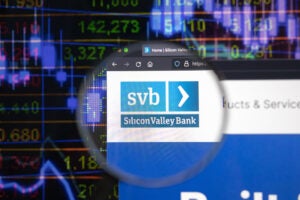For everyone out there with a pair of eyes, ears or a smartphone; the initials “SVB” have probably started floating around if the periphery of your awareness. Maybe you’ve even asked what those letters stand for.
So let’s clarify some of the financial sector’s recent difficulties and what someone involved in agriculture should be considering in light of them.
First things first, we’re observing a bank collapse in real time for the first time in a few years, and it can revive some vivid memories of 2008 and/or 1985, depending on how old you are. And that’s OK. But it’s also the first time a bank run was fueled by the Twitterverse, and that’s probably not OK.
SVB, formally known as Silicon Valley Bank, was/is the 16th largest bank in the U.S., holding a California state charter. It was founded in 1983 and has focused on non-traditional lending to start up companies and venture capital firms. It filed for Chapter 11 bankruptcy protection this month following customers’ mad dash to pull their deposits from the lender in a what could be seen as a classic run on the bank. And, of course, with its size and connection to the tech industry, it’s become big news.
It’s also significant for the agricultural industry because, as Agri-Pulse reported, SVB’s clients included ag-data company Farmers Business Network, vertical ag producer Bowery Farming, plant-based zealot Impossible Foods, and many wineries.

But there are actually many moving parts to its failure: The two most important are the current interest rate climate and the psychological contagion that fuels runs on banks. (Side note: One should always be wary of large groups of scared people. Nothing rational happens in these situations.)
Next, problems came to the doorsteps of Signature Bank and then First Republic Bank. Signature was shuddered by the state of New York, and First Republic is in negotiations for a rescue package from some of the biggest banks in the world.
What is a bank run?
We all took high school history and likely heard the term “bank run” thrown around when discussing the Great Depression and the events surrounding it. The (very) basic definition of a bank run occurs when many clients withdraw their money from a bank, because they believe the bank may fail in the near future.
When companies that banked with SVB started to feel the recent economic pinch, they began slowly depleting their on deposit cash to continue to operate. Simultaneously, the pile of bonds that SVB invested in had plummeted in value with interest rate hikes, leaving them sitting on another pile of unrealized losses.
Word gets out that the road is bumpy, depositors show up in droves to withdrawal on-demand deposits, the cash on hand falls below the regulatory requirements, and the FDIC rolls in to change the locks and circle the wagons. It’s strange to think that rate increases can cause a bank to lose money, but spread banking and bond investing are topics for another day.
Signature and First Republic are in similar situations, albeit some nuances are different. Signature was heavily invested in cryptocurrency assets, and First Republic had a loan to deposit ratio of 111 percent, which seems unwise to me, but no one asked me.
So what does the FDIC do?
You may already know, and if you don’t ask any living relative over the age of 70. I bet they’re all walking a bit taller this week due to a feeling of vindication. When I worked in bank wealth management, I learned to play the FDIC game for mature clients who had lived through some things, and that’s a whole other story as well.
The Federal Deposit Insurance Corporation is a government-owned corporate entity that provides a backstop to protect depositors in the event of a bank failure. They’ll make each depositor whole, to the tune of a maximum of $250,000 per named account holder in the event of a failure/run. They also monitor the regulatory deposit requirements of any bank that is FDIC insured and take control of the entity in the
event of failure, such as the SVB debacle.
If your deposits exceed $250,000, your protection is limited to the 250k cap. You can carry the deposits under different names, entities, etc. and increase your overall insurance protection.
What about my bank?
There are two important things to consider when evaluating whether you should worry about your bank. The first is their general financial condition, which you can look into on their website, and if you’re pretty handy with government websites, check this one out.
Second, learn about how they make money. Do they have a large book of loans concentrated in one industry? Do they cater to a certain demographic? Is their business diverse or specialized? Do they have a large book of loans that aren’t secured by hard assets (i.e. operating loans)? If you feel as though the way they generate income and take risk is subject to volatility factors beyond their control to a degree that you think is unacceptable, consider some making some changes.

Now more than ever, the farmer is a businessperson. Get to know the business of your partners to make your business better.
You can also ask your banker. Depending on their character, knowledge of the industry they work in, and relationship with you, they might give you accurate insight. You may consider having more than one banking relationship, which is generally advisable no matter the circumstances. The old “all your eggs in one basket” adage applies in so many places.
Overall, I don’t think we’re looking down the barrel of a widespread systemic shock like we did 15 years ago. I could be wrong. A little shakeup to root out complacency can be a good thing. Know your bank, know your books, and take well calculated risk regardless of what happens in Silicon Valley or New York.
Not that I needed to tell you that.
Katie Ogden owns and operates Wildcatter Wealth Management LLC in Laramie, Wyoming. She’s a 2007 graduate of the University of Wyoming with a bachelor’s degree in Agriculture Business and has been working in financial services to help ranch and farm families ensure a prosperous future ever since.



